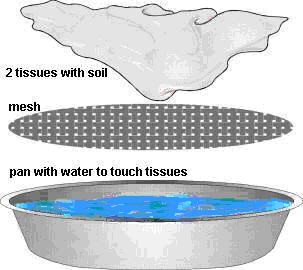| Extracting Nematodes from Soil Samples |

|
 1) collect soil from around plant roots
1) collect soil from around plant roots
2) wrap a small handful of soil in two layers of facial tissue
3) place the wrapped soil in a small dish on top of a mesh or screen. Add water so that the mesh is slightly covered with water and the soil contacts the water.
4) let sit 1-3 days to allow the nematodes to crawl out of the soil. Make sure the sample stays in contact with the water - do not let the dish become dry. Covering the dish with plastic wrap or foil will help prevent drying.
5) remove the bundled soil from the dish and observe the water in the dish using a binocular dissecting microscope (you will even be able to see many nematodes with a magnifying glass)
Notes:
1) This method only works with live nematodes, the nematodes follow gravity and crawl into the water. Collect moist soil during your normal growing seasons, do not let the sample get hot or dry and extract nematodes soon after you collect your soil sample. Nematodes will survive for a few days in plastic bags in the refrigerator.
2) There will be a lot of organisms visible other than nematodes!! Look at those too.
3) To make finding nematodes in your sample easier, you may want to decrease the volume of water. Since nematodes are slightly heavier than water you can remove excess water by centrifugation or allowing the nematodes to settle to the bottom of a narrow container and decanting (remove the upper 90%).
If you are interested in more involved laboratory techniques for extracting nematodes see"Some Procedures for Collecting and Preparing Nematodes for Study"
